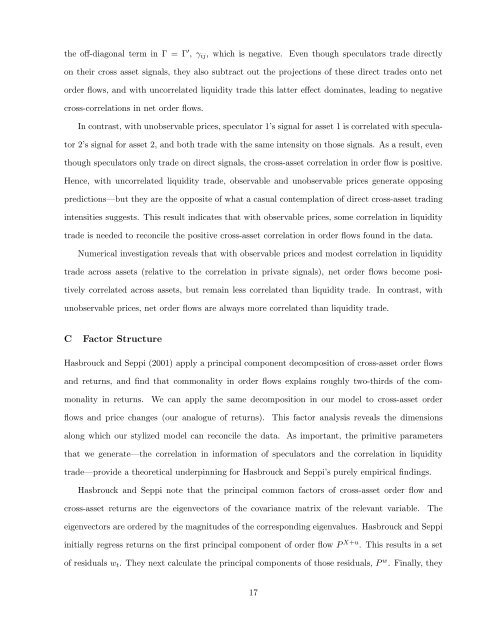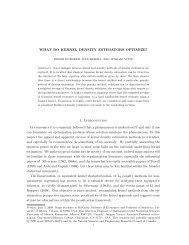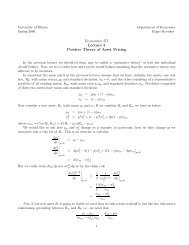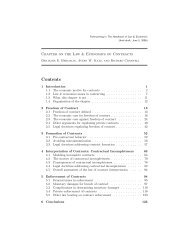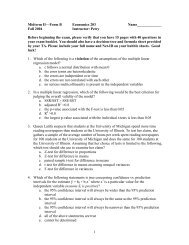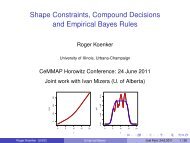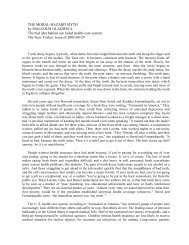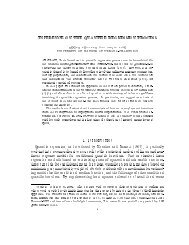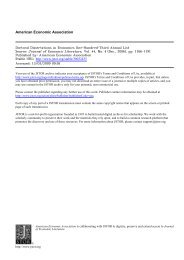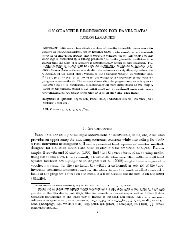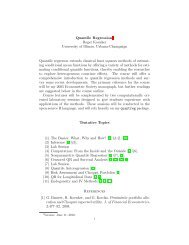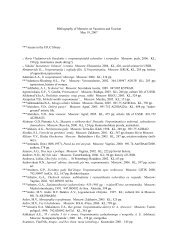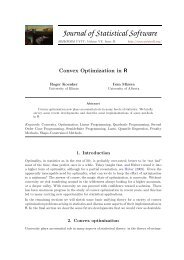Cross-Asset Speculation in Stock Markets∗ - Econometrics at Illinois ...
Cross-Asset Speculation in Stock Markets∗ - Econometrics at Illinois ...
Cross-Asset Speculation in Stock Markets∗ - Econometrics at Illinois ...
Create successful ePaper yourself
Turn your PDF publications into a flip-book with our unique Google optimized e-Paper software.
the off-diagonal term <strong>in</strong> Γ = Γ ′ , γ ij , which is neg<strong>at</strong>ive. Even though specul<strong>at</strong>ors trade directlyon their cross asset signals, they also subtract out the projections of these direct trades onto netorder flows, and with uncorrel<strong>at</strong>ed liquidity trade this l<strong>at</strong>ter effect dom<strong>in</strong><strong>at</strong>es, lead<strong>in</strong>g to neg<strong>at</strong>ivecross-correl<strong>at</strong>ions <strong>in</strong> net order flows.In contrast, with unobservable prices, specul<strong>at</strong>or 1’s signal for asset 1 is correl<strong>at</strong>ed with specul<strong>at</strong>or2’s signal for asset 2, and both trade with the same <strong>in</strong>tensity on those signals. As a result, eventhough specul<strong>at</strong>ors only trade on direct signals, the cross-asset correl<strong>at</strong>ion <strong>in</strong> order flow is positive.Hence, with uncorrel<strong>at</strong>ed liquidity trade, observable and unobservable prices gener<strong>at</strong>e oppos<strong>in</strong>gpredictions—but they are the opposite of wh<strong>at</strong> a casual contempl<strong>at</strong>ion of direct cross-asset trad<strong>in</strong>g<strong>in</strong>tensities suggests. This result <strong>in</strong>dic<strong>at</strong>es th<strong>at</strong> with observable prices, some correl<strong>at</strong>ion <strong>in</strong> liquiditytrade is needed to reconcile the positive cross-asset correl<strong>at</strong>ion <strong>in</strong> order flows found <strong>in</strong> the d<strong>at</strong>a.Numerical <strong>in</strong>vestig<strong>at</strong>ion reveals th<strong>at</strong> with observable prices and modest correl<strong>at</strong>ion <strong>in</strong> liquiditytrade across assets (rel<strong>at</strong>ive to the correl<strong>at</strong>ion <strong>in</strong> priv<strong>at</strong>e signals), net order flows become positivelycorrel<strong>at</strong>ed across assets, but rema<strong>in</strong> less correl<strong>at</strong>ed than liquidity trade. In contrast, withunobservable prices, net order flows are always more correl<strong>at</strong>ed than liquidity trade.C Factor StructureHasbrouck and Seppi (2001) apply a pr<strong>in</strong>cipal component decomposition of cross-asset order flowsand returns, and f<strong>in</strong>d th<strong>at</strong> commonality <strong>in</strong> order flows expla<strong>in</strong>s roughly two-thirds of the commonality<strong>in</strong> returns. We can apply the same decomposition <strong>in</strong> our model to cross-asset orderflows and price changes (our analogue of returns). This factor analysis reveals the dimensionsalong which our stylized model can reconcile the d<strong>at</strong>a. As important, the primitive parametersth<strong>at</strong> we gener<strong>at</strong>e—the correl<strong>at</strong>ion <strong>in</strong> <strong>in</strong>form<strong>at</strong>ion of specul<strong>at</strong>ors and the correl<strong>at</strong>ion <strong>in</strong> liquiditytrade—provide a theoretical underp<strong>in</strong>n<strong>in</strong>g for Hasbrouck and Seppi’s purely empirical f<strong>in</strong>d<strong>in</strong>gs.Hasbrouck and Seppi note th<strong>at</strong> the pr<strong>in</strong>cipal common factors of cross-asset order flow andcross-asset returns are the eigenvectors of the covariance m<strong>at</strong>rix of the relevant variable. Theeigenvectors are ordered by the magnitudes of the correspond<strong>in</strong>g eigenvalues. Hasbrouck and Seppi<strong>in</strong>itially regress returns on the first pr<strong>in</strong>cipal component of order flow P X+u . This results <strong>in</strong> a setof residuals w t . They next calcul<strong>at</strong>e the pr<strong>in</strong>cipal components of those residuals, P w . F<strong>in</strong>ally, they17


